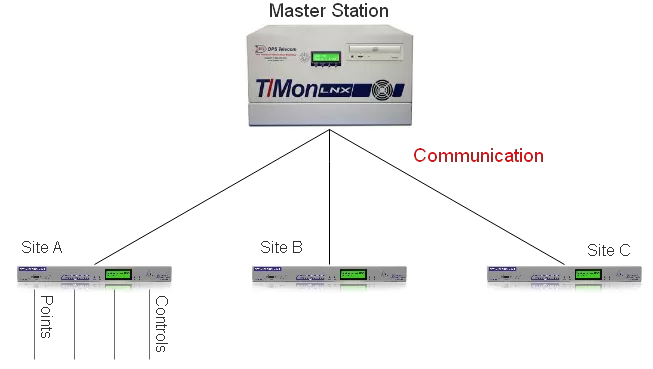Download our free SCADA tutorial.
An introduction to SCADA from your own perspective.
1-800-693-0351
Have a specific question? Ask our team of expert engineers and get a specific answer!
Sign up for the next DPS Factory Training!

Whether you're new to our equipment or you've used it for years, DPS factory training is the best way to get more from your monitoring.
Reserve Your Seat TodaySupervisory Control and Data Acquisition (SCADA) equipment provide distributed monitoring and control capability. A SCADA solution uses a network of interconnected SCADA equipment to create a Remote Monitoring and Control System.

A SCADA solution provides a user with data acquisition, networked data communication, data presentation, and control. These processes are enabled by real-time data collection. A SCADA management system allows you to:
The components that collect and manage this data across equipment are sensors, Remote Terminal Units (RTUs), Intelligent Electronic Devices (IEDs), SCADA master units (also called SCADA HMI software), and the communication network.
Monitoring functions are a component of any SCADA software solution while control functions may only be found in more modern SCADA systems. The system architecture involves RTUs collecting data from sensors across the network. The RTU, possibly after some local processing, passes data to the HMI (Human-Machine Interface) or SCADA Master, which then translates the data into a human-readable form.
The main benefit that SCADA applications will give you is that you and your techs are able to remotely monitor and control your mission-critical devices deployed at many different remote sites. Other than that, SCADA systems can provide you with many important insights into how well your network is operating and what areas you could benefit from more attention.
SCADA systems can bring you many other advantages, some of them are:
Remember that the more data your SCADA system is able to collect, process and analyze, the easier it will be for you to identify problem areas in your remote sites.
These systems allow operators to easily view their network alarms in one comprehensive window, making an alarming SCADA solution a powerful tool for network monitoring. These systems can be used to manage any type of equipment and can be useful in almost any industry. This includes industries that commonly deploy SCADA solutions, such as the water and waste control, energy, oil and gas refining, transportation, and telecommunications industries.
SCADA systems are vital not only for large scale organizations, but also for any company that needs to maintain high efficiency, process data for informed decisions, and reports issues to techs that will act to avoid system downtime.
It's important to keep in mind that SCADA systems are the means to an end - not the final goal itself. All businesses aim to maximize profits through operational efficiency. For that, all businesses need to find ways to increase productivity, efficiency, quality and reliability, all to stay competitive.
SCADA systems help organizations to remain competitive by leveraging efficiency and productivity, reducing costs and giving you control over devices and processes.
A SCADA network is a long-term investment that needs to show efficiency. The usual lifespan of SCADA devices is around 15 years, so you need to take into consideration how your system will evolve over the course of these years. To make sure your SCADA system will be able to meet your future needs, choose devices with the capability to scale up.
Also, be sure to select a vendor with a proven history of being able to support new technologies. This way, you have the flexibility to update your system and/or incorporate new features and functionalities as your network changes and grows.
An example of efficient SCADA equipment is the T/Mon SLIM Remote Alarm Monitoring System by DPS Telecom. This master station puts control over your alarms directly into your hands. T/Mon SLIM is a new model of the T/Mon Remote Alarm Monitoring System, scaled to the needs of small, local and regional networks.
It allows you to monitor 10,000 alarm points and consolidate alarms from several sites into a single local or regional network. Additionally, it allows you to monitor up to 64 individual network devices in just one easy to read display, saving both time and money.
If you need to mitigate problems that might challenge your remote facilities, then you have to get fast, competent notifications and as well as tools to allow you to be able to predict possible issues in the future. So, you need the best equipment to stay ahead of the competition and avoid significant downtime.
The T/Mon SLIM is only one example of an efficient SCADA component. If you need an HMI with more capacity, we have it covered. If you need competent RTUs and sensors, we can provide these too. Whatever your current situation is, we can build a device that will meet your requirements.
We are a leader in the remote monitoring manufacturing market, and we achieved this position by producing custom solutions to attend our clients' needs. We'are a vertically integrated company, so designing and building to your specs is our specialization.
Our capable engineers can help you to fully leverage your alarm management solution, allowing you to control and communicate with your remote devices through a perfect-fit monitoring platform. Reach out to our team today and find out how we can maximize your network potential.
Related Topics: